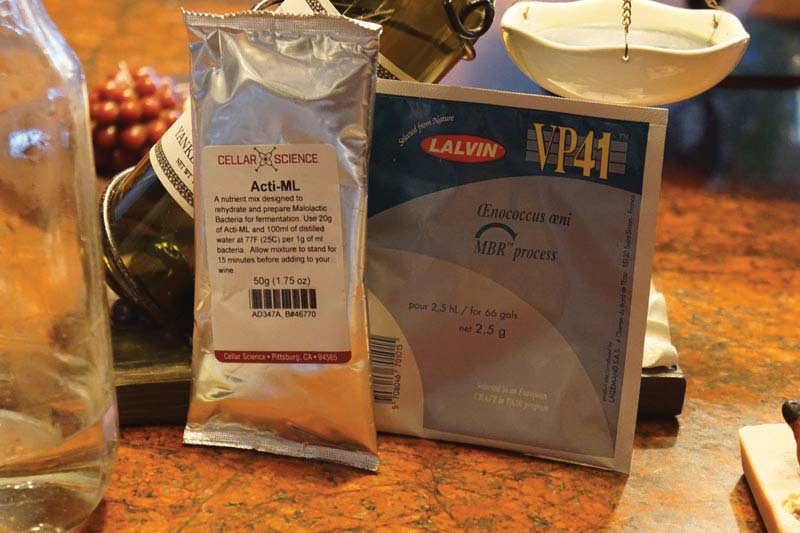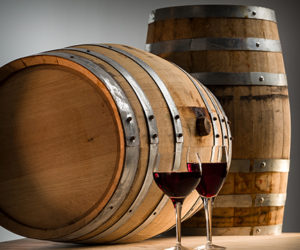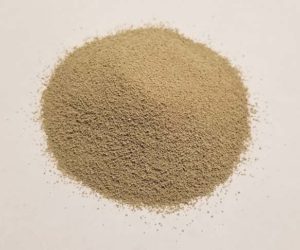Q This year’s harvest from my 20 Cabernet Franc vines made 7 gallons (26.5 L), which I fermented in two plastic fermenters to a gravity of 1.000 and then started malolactic fermentation. I then transferred into two 3-gallon (11-L) carboys and a 1-gallon (3.8-L) carboy. It has now been just about 10 days and malolactic fermentation seems to be going well (slow bubbling) but one of the carboys has nice, fairly clear red wine while the other has cloudy wine. I checked pH and the cloudy wine was 3.77 while the clear wine was 3.57. Can you offer any explanation?
Donald Coustan
Jamestown, Rhode Island
A Well, it’s tough to say what would make one cloudy and the other clear, except for the fact that they may not have been identical coming from your fermenters. If you did blend/homogenize after pressing, then it’s possible you’re seeing the cloudy wine (pH 3.77) going through the MLF (malolactic fermentation) a little more quickly for whatever reason (is it stored in a slightly warmer place than the other one?), and, as MLF de-acidifies, it makes sense that the pH on the cloudy one is a little higher (high titers of microbes can cause cloudiness). Cabernet Franc isn’t necessarily more prone than other wines to having delayed MLF. Even if your post-press lots didn’t start out with the same acid levels, those are both perfectly fine pH levels to have healthy MLF.
Most MLFs, no matter what the varietal, are finicky things. The ML bacteria are greatly affected by the following: Low pH, high alcohol, low storage temperature, or high sulfur dioxide levels (free SO2 above 10 ppm or a total SO2 above 60 ppm). ML bacteria (usually Oenococcus oeni and various Lactobacillus and Pediococcus species) are also nutritionally fastidious, meaning that if the balance of nutrients in their environment isn’t correct, things can go off the rails.

sulfur dioxide, and the temperature. Photo by Dominick Profaci
Before you have any further issues with one of your Cabernet Franc lots having a delayed MLF, I will offer some tips on how you can have a successful malolactic fermentation every time.
Tips to ensure a healthy malolactic fermentation
Temperature: Is it temperature that stopped your ML bacteria? Sometimes when a cold end to the harvest season follows our warm primary fermentations, the temperatures where we store our wines (basements, garages, outbuildings, etc.) drop right along with the thermometer. Temperatures much below 55 °F (13 °C) spell bad news for active MLF so try to keep your fermenters warm until they are through both primary and secondary fermentation. Keeping temperatures above 50 °F (10 °C) will help bacteria survive, and above 55–60 °F (13–16 °C) will keep them happy and fermenting. If you can’t change the environment itself, try a low-temperature ML bacteria strain. Lalvin 31 (see lallemandwine.com for product information) and low-temperature-tolerant strains like it should help through challenging conditions. Each strain should have a minimum temperature it will ferment at, so check manufacturer’s details. Want to warm up one or both of your carboys? Try wrapping an electric blanket around them on a very low setting. But be sure to monitor to make sure they don’t get too hot!
Temperatures much below 55 °F (13 °C) spell bad news for active MLF so try to keep your ferments warm until they are through both primary and secondary fermentation.
pH: In other parts of the winemaking world, especially colder areas where grapes get less sunlight during the growing season, low pH (high acidity) is frequently the anti-MLF culprit. Most bacteria just simply like to live in an environment with lower acidity levels (higher pH). Even though your pHs are both fine for red wine work, it is definitely possible your ML bacteria are just getting off to a slower start in the 3.56 environment. In situations where I’ve got a pH under 3.4 I use CHR Hansen Viniflora CH35, which is well suited to low pH and high total SO2 situations. It is especially helpful in years where you might add more SO2 at the crusher due to rot or Botrytis.
Alcohol: Alcohol can degrade the delicate cell membrane of both yeast and bacteria, which is part of the reason that yeast cells decline and eventually die as the alcohol levels climb during primary fermentation. Alcohol levels much over 14.5% can be a challenge for yeast and ML bacteria alike, which is one of the reasons I always recommend adding sufficient water to bring your Brix into a safe fermentation level — under 25 °Brix if possible. If hydration isn’t your thing, Lalvin’s VP4 and PN4 products are both suited to high ethanol concentrations, 15.5% and 16% respectively. I’m not sure what your alcohol is right now, but since you can’t change it at this point, you’ve got to move other levers here in this situation.
SO2: High sulfur dioxide (free or total) can be damaging to malolactic bacteria. You can probably add up to 60 ppm SO2 to must or juice before fermentation and enough will get bound up so you will still be able to carry out an MLF a couple of weeks later when the wine is dry, but free SO2, especially when in finished wine with alcohol over 13%, is extremely harmful to lactic acid bacteria. Did you put in a lot of sulfur dioxide as you crushed the grapes? The best way to avoid having high free SO2 in your wine being a barrier to MLF is to not add too much at the wrong times in the first place. Never add more than 60 ppm before primary fermentation (30–40 ppm is much more reasonable) and never add SO2 post-fermentation until MLF is complete, unless it just won’t go through after you’ve tried everything, at which point you should add SO2 to save what quality you have and move on.
Micronutrients: Sometimes, especially with over-ripe or rot-infected fruit, the must or juice will be low in micronutrients that ML bacteria need in order to thrive. If you anticipate MLF troubles, especially if you know you’re dealing with some of the adverse conditions I have already mentioned, it might be wise to invest in a dose of ML bacteria nutrition. They may seem expensive, but usually a tiny dose is all you need. These nutrients may be an item you want to buy together with your home winemaking club or group of winemaking buddies. That way you can buy a bigger package and save money and ensure that what you do buy will be used up by each of you.
Robust culture: For home winemakers I almost always recommend using a direct-add (i.e., freeze-dried and powdered) ML bacteria instead of the old-fashioned liquid cultures. With the direct-add powder there are just fewer ways human error can get in the mix. If you do use the freeze-dried culture, be sure that it has been stored appropriately, which most often is in the freezer. Don’t keep ML bacteria around for longer than a single harvest; be sure to buy new bacteria each year. Similarly, don’t use bacteria where the package has been open for a long time.
I’m not sure if you were looking for a primer on malolactic fermentation, but I’ve laid out a lot of information my winemaking veterans out there can use too. I think you’re going to be fine; 10 days is not very long into a malolactic fermentation, which, depending on ambient temperatures, can take many weeks or even a few months to complete.
Q My 2021 Merlot (I’m up in Washington State) finished out fermentation with a pH of 3.85. I added some tartaric acid (about 0.5 g/L) right before fermentation, but that pH is a little higher than I’d want. Is it OK to add tartaric acid after fermentation? Any tips on how to do it so I don’t overdo it?
Clay Johnson
Leavenworth, Washington
A Great topic and great questions. If you’ve read my columns over the years, you’re familiar with my mantra of acid being the “backbone” of wine, as well as the importance of having the correct pH for long-term aging. The higher the pH (lower acidity), the more spoilage organisms like Lactobacillus and Acetobacter can get a foothold and perhaps eventually spoil your wine. Additionally, having a higher acid level helps your free SO2 additions be more effective; the lower the acid level, the more SO2 you must add for a comparative efficacy.
Post-malolactic fermentation (MLF) I like to keep my red wines below 3.65 pH and my whites below 3.5. Oftentimes, as you know, the pH will creep back up after primary fermentation or, post-press, will be much higher than you anticipated, even with a pre-fermentation acid addition. This is extremely normal and happens even to professional winemakers (shhh, just don’t tell anyone!). Because post-primary fermentation pH is really hard to predict, tweaking that pH back down with a little tartaric acid can be just the ticket.
Here’s how to plan for and think about your post-fermentation acid additions:
Add at the right time: While it’s always best to do “big moves” on wine chemistry as early as possible (this gives the wine time to adjust and integrate over time) by acidulating before you begin primary fermentation, it’s OK to adjust afterwards. I recommend doing this immediately after MLF has completed so you don’t give potential spoilage organisms a chance to get much of a foothold. Another reason not to wait: If you add acid right before bottling it can stick out style-wise like a sore thumb and will not taste like a natural, integrated part of the wine.
Do bench trials first: Ah, the Wine Wizard’s other mantra: “Do your bench trials, my children!” (How many years have you been hearing me say that?) Well, I repeat it so often because it’s so important. There’s nothing worse than trying to make a little tweak only to find that you’ve made your wine so tart it’s undrinkable. The solution is to do tiny trials using small, measured amounts of your wine as well as
your additive. My favorite volume to work with is 50 mL of wine. Then you can either measure in dry powder (if you have a scale that goes down to units that small) or dose in little amounts of a 10% (10 g/100 mL) solution of tartaric acid until you get to a level that has the taste and balance you want.
If you’ve got a pH meter and can check what kind of final measurement that gives you, even better. If you’re serious about winemaking (or brewing, or kombucha, or cider, etc.) you’ll want to invest in a couple of micropipettes (Eppendorf is a classic brand, but there are other, cheaper options available. Micropipettes, which can measure out 5–100 or 100–1,000 microliters. Note that 1,000 microliters = 1 mL) to allow one the ability to run all sorts of bench trials on small amounts of wine and even smaller amounts of additives.
Another great benefit of acidulating after your wine is pressed is that you can measure out exactly how much you’ll need, an almost impossible task when your grapes are sitting on skins.
Re-check post-addition: After you make your tartaric addition (after your bench trials show you the indicated amount), make the addition, stir it into the wine completely, and re-check the pH and titratable acidity, or TA, (if you can) about 24–48 hours afterwards. This will help to ascertain if your addition was done correctly.
Keeping your acidity at appropriate levels (high enough, pHs low enough) after malolactic fermentation is complete is critical for proper wine health and aging. Not only will an appropriate acid level make sure spoilage bacteria have a harder time getting a foothold, it’ll make your wine taste more balanced and will make your free SO2 additions more effective. Best of luck with your wine!







